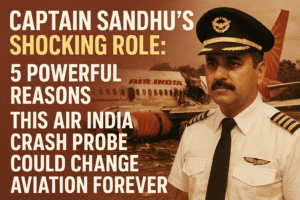Captain Sandhu’s Shocking Role: 5 Powerful Reasons This Air India Crash Probe Could Change Aviation Forever
Captain RS Sandhu’s involvement in the Air India crash investigation marks a pivotal shift in how aviation disasters are scrutinized in India. With over 40 years at Air India, including direct experience with the 787-8 fleet and the very aircraft that crashed, his technical and institutional insight is unparalleled.
His post-retirement work with Tata’s airline integration adds vital knowledge of current operational pressures and maintenance systems. Unlike standard probes, his inclusion addresses growing concerns about the AAIB’s transparency and credibility, especially after cockpit audio hinted at confusion over fuel switch handling. Pilot unions demanded operational voices, and Sandhu delivers exactly that—offering expert interpretation of crew dynamics, system protocols, and maintenance records.
His presence aims to restore faith in the investigative process while helping decode whether the crash resulted from human error, mechanical failure, or procedural gaps. With global attention and 260 lives lost, his role is both technical and symbolic—bridging the gap between data and frontline aviation realities.

Captain Sandhu’s Shocking Role: 5 Powerful Reasons This Air India Crash Probe Could Change Aviation Forever
The inclusion of Captain RS Sandhu in the AAIB’s investigation into June’s catastrophic Air India flight isn’t just procedural—it’s a critical response to systemic questions about aviation safety transparency. Sandhu’s appointment carries weight few outsiders might recognize, revealing how this probe diverges from standard protocol.
The Unspoken Significance of Sandhu’s Credentials
Beyond his 40-year tenure at Air India, Sandhu’s expertise cuts to the heart of this specific tragedy:
- As the original examiner for Air India’s 787-8 fleet, he helped establish the aircraft’s operational protocols.
- He personally accepted delivery of VT-ANB in 2013, giving him intimate knowledge of this airframe’s history.
- His post-retirement work leading Tata’s airline integration means he understands contemporary maintenance ecosystems and corporate pressures.
This trifecta of experience—technical, historical, and organizational—positions him uniquely to decode contradictions in the preliminary report.
Addressing the Investigation’s Credibility Crisis
The AAIB’s move follows vocal demands from pilot unions like ALPA India for operational expertise at the table. The chilling cockpit recording excerpt—where pilots disputed who cut the fuel switches—exposed potential human factors or system failures that demand aviation-operational context. Sandhu’s presence signals recognition that:
- Pure engineering analysis risks missing crew resource management nuances
- Airline-specific procedures (e.g., switch protocols) require insider interpretation
- Survivor testimony (the lone passenger) needs cross-referencing with operational realities
The Bigger Picture: Restoring Trust in Indian Aviation
With 260 lives lost and global scrutiny on India’s aviation safety infrastructure, Sandhu’s involvement serves a dual purpose:
- Technical rigor: His hands-on 787 expertise can validate or challenge findings about aircraft systems.
- Stakeholder trust: As an independent consultant (via Aviazione) with legacy credibility, he bridges skepticism between regulators, airlines, and crews.
Notably, his consultancy work post-retirement implies familiarity with modern safety analytics—tools that may trace hidden maintenance trends or training gaps.
What Comes Next: The Investigation’s Critical Path
Sandhu’s first priority will likely focus on reconciling the preliminary report’s findings with:
- Crew training records
- Maintenance logs of VT-ANB
- Boeing’s operational bulletins for the 787-8
- ATC communications during takeoff
His most valuable contribution may be interpreting whether the fuel switch cutoff was intentional, accidental, or system-induced—a question haunting the aviation community.
You must be logged in to post a comment.